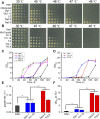Meiosis-Based Laboratory Evolution of the Thermal Tolerance in Kluyveromyces marxianus
- PMID: 35087802
- PMCID: PMC8786734
- DOI: 10.3389/fbioe.2021.799756
Meiosis-Based Laboratory Evolution of the Thermal Tolerance in Kluyveromyces marxianus
Abstract
Kluyveromyces marxianus is the fastest-growing eukaryote and a promising host for producing bioethanol and heterologous proteins. To perform a laboratory evolution of thermal tolerance in K. marxianus, diploid, triploid and tetraploid strains were constructed, respectively. Considering the genetic diversity caused by genetic recombination in meiosis, we established an iterative cycle of "diploid/polyploid - meiosis - selection of spores at high temperature" to screen thermotolerant strains. Results showed that the evolution of thermal tolerance in diploid strain was more efficient than that in triploid and tetraploid strains. The thermal tolerance of the progenies of diploid and triploid strains after a two-round screen was significantly improved than that after a one-round screen, while the thermal tolerance of the progenies after the one-round screen was better than that of the initial strain. After a two-round screen, the maximum tolerable temperature of Dip2-8, a progeny of diploid strain, was 3°C higher than that of the original strain. Whole-genome sequencing revealed nonsense mutations of PSR1 and PDE2 in the thermotolerant progenies. Deletion of either PSR1 or PDE2 in the original strain improved thermotolerance and two deletions displayed additive effects, suggesting PSR1 and PDE2 negatively regulated the thermotolerance of K. marxianus in parallel pathways. Therefore, the iterative cycle of "meiosis - spore screening" developed in this study provides an efficient way to perform the laboratory evolution of heat resistance in yeast.
Keywords: Kluyveromyces marxianus; PDE2; PSR1; iterative cycle; laboratory evolution; meiosis; thermal tolerance.
Copyright © 2022 Wu, Lyu, Wu, Luo, Zeng, Shi, Zhou, Yu and Lu.
Conflict of interest statement
The authors declare that the research was conducted in the absence of any commercial or financial relationships that could be construed as a potential conflict of interest.
Figures



Similar articles
-
Kluyveromyces marxianus developing ethanol tolerance during adaptive evolution with significant improvements of multiple pathways.Biotechnol Biofuels. 2019 Mar 22;12:63. doi: 10.1186/s13068-019-1393-z. eCollection 2019. Biotechnol Biofuels. 2019. PMID: 30949239 Free PMC article.
-
Engineering Kluyveromyces marxianus as a Robust Synthetic Biology Platform Host.mBio. 2018 Sep 25;9(5):e01410-18. doi: 10.1128/mBio.01410-18. mBio. 2018. PMID: 30254120 Free PMC article.
-
Thermotolerant Yeast Kluyveromyces marxianus Reveals More Tolerance to Heat Shock than the Brewery Yeast Saccharomyces cerevisiae.Biocontrol Sci. 2018;23(3):133-138. doi: 10.4265/bio.23.133. Biocontrol Sci. 2018. PMID: 30249963
-
Kluyveromyces marxianus as a host for heterologous protein synthesis.Appl Microbiol Biotechnol. 2016 Jul;100(14):6193-6208. doi: 10.1007/s00253-016-7645-y. Epub 2016 Jun 3. Appl Microbiol Biotechnol. 2016. PMID: 27260286 Review.
-
The yeast Kluyveromyces marxianus and its biotechnological potential.Appl Microbiol Biotechnol. 2008 Jun;79(3):339-54. doi: 10.1007/s00253-008-1458-6. Epub 2008 Apr 22. Appl Microbiol Biotechnol. 2008. PMID: 18427804 Review.
Cited by
-
Establishment of a Cre-loxP System Based on a Leaky LAC4 Promoter and an Unstable panARS Element in Kluyveromyces marxianus.Microorganisms. 2022 Jun 17;10(6):1240. doi: 10.3390/microorganisms10061240. Microorganisms. 2022. PMID: 35744758 Free PMC article.
-
Investigating the Impact of Blunt Force Trauma: A Probabilistic Study of Behind Armor Blunt Trauma Risk.Ann Biomed Eng. 2024 Jun 26. doi: 10.1007/s10439-024-03564-3. Online ahead of print. Ann Biomed Eng. 2024. PMID: 38922366
-
Exploring fungal bioemulsifiers: insights into chemical composition, microbial sources, and cross-field applications.World J Microbiol Biotechnol. 2024 Mar 7;40(4):127. doi: 10.1007/s11274-024-03883-6. World J Microbiol Biotechnol. 2024. PMID: 38451356 Review.
References
LinkOut - more resources
Full Text Sources

